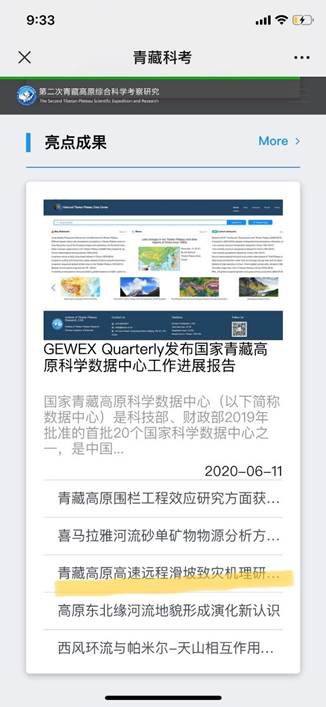Recently, the Contributions of Rock Mass Structure to the Emplacement of Fragmenting Rockfalls and Rockslides: Insights from Laboratory Experiments, a paper of doctoral student Lin Qiwen from Professor Cheng Qiangong's team published in the Journal of Geophysical Research: Solid Earth was selected as a highlight of the Second Tibetan Plateau Scientific Expedition and Research.
General Secretary Xi Jinping has pointed out that the Tibetan Plateau "is the roof of the world, the water tower of Asia, the third pole of the earth, an important ecological security barrier and a strategic resource reserve base of China, and an important protected area for Chinese culture with national characteristics". Furthermore, the Tibetan Plateau, as the most unique geological-geographical-resource-ecological unit on the earth, is a natural laboratory for conducting research on the evolution of the earth and life, the interactions between the Earth spheres and the man-earth relationship. The Tibetan Plateau, as the core driving area of environmental change of the "Belt and Road", will pose huge challenges to the survival and development of more than 20 countries and more than 3 billion people along the "Belt and Road". As a new era is coming, the Second Tibetan Plateau Scientific Expedition and Research was carried out systematically, focusing on comprehensive cross-over research, and strengthening collaborative innovation and international scientific and technological cooperation will provide important scientific and technological support for "safeguarding the last pure land in the world", "developing a beautiful Tibetan Plateau" and building a Green Silk Road. On August 19, 2017, General Secretary Xi Jinping sent a letter on the Second Tibetan Plateau Scientific Expedition and Research, requiring to "focus on water, ecology, and human activities, strive to solve the issues concerning the resource environmental bearing capacity, disaster risks, and green development approaches of the Tibetan Plateau, make new contributions to safeguarding the last pure land in the world and developing a beautiful Tibetan Plateau, and enable the people of all ethnic groups on the Tibetan Plateau to live a happier and healthier life", which reflected that the Tibetan Plateau Scientific Expedition and Research plays an important role in major technological deployment and socio-economic development of China.
The Second Tibetan Plateau Scientific Expedition and Research, based on the first research, will be conducted by the team headed by Academician Yao Tandong. The second research will focus on the changes, with the aim to find out the law of change, evaluate and predict future change trends, strengthen the transfer and transformation of the results, the sharing and integration of data and the integration of enterprises, universities and research institutes, support the high-quality regional economic and social development, expand the international horizon, carry out wide-area joint research, and serve the global ecological environment protection and the construction of a community with a shared future for mankind. There are 10 tasks in this Tibetan Plateau scientific expedition and research , including Synergy and Impact of Westerly Wind and Monsoon, Dynamic Changes and Effects of Asia's Water Tower, Ecosystem and Ecological Security, Function and Optimization System of the Ecological Security Barrier, Biodiversity Conservation and Sustainable Utilization, Human Activities and Living Environment Security, Plateau Growth and Evolution, Current Situation and Prospect Assessment of Resources and Energy, Geological Environment and Disasters, and Regional Green Development Approach.
The team of Professor Cheng Qiangong undertook the sub-project of Task 9: Geological Environment and Disasters to conduct expedition and research on the high-speed long-distance landslide disasters in the Tibetan Plateau. The Tibetan Plateau is the roof of the world, the water tower of Asia and the third pole of the earth. The research on the dynamics mechanism of geological disasters on the Tibetan Plateau, disclosure of the geological disasters and environmental effects of the Tibetan Plateau under the background of the interaction between tectonic activities and climate change are the research hotspots and frontier science issues in field of geosciences. Since the 20th century, the development frequency of high-speed long-distance landslides in the Tibetan Plateau has gradually increased with global warming and glacier recession. Existing studies have shown that the development and distribution of giant high-speed long-distance landslides in orogenic belts of global plate boundaries are closely related to regional tectonic activities and climate change, and are indicators of their interaction. Therefore, the expedition and research on the high-speed long-distance landslide disasters on the Tibetan Plateau is of great significance for revealing the evolution history of the structure, environment and climate of the plateau area, and for evaluating the geomorphic evolution of the plateau at different time scales in the future.
Paper information: Lin Qiwen, Cheng Qiangong, Li Kun, Xie Yu, Wang Yufeng. (2020). Contributions of rock mass structure to the emplacement of fragmenting rockfalls and rockslides: Insights from laboratory experiments. Journal of Geophysical Research: Solid Earth, 125, e2019JB019296.
Paper link: https://doi.org/10.1029/2019JB019296
About the results of the paper: /info/1072/6916.htm
Website of Second Tibetan Plateau Scientific Expedition and Research: http://www.step.ac.cn






